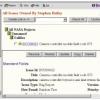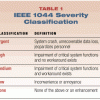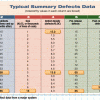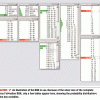|
|
Our Experience Using Orthogonal Defect Classification Orthogonal Defect Classification (ODC) is a method of classifying and analyzing software defects. Using real-life experience, Barbara Hirsh discusses how Motorola successfully implemented ODC within their organization resulting in a framework for building a pervasive and cohesive defect prevention program. Learn the benefits of using ODC from the perspective of the developer, the tester, and the post-release analyst.
|
Barbara Hirsh, Motorola
|
|
|
Simple Software Defect Categorization for Defect Prevention Based on her experience with software development organizations at all five levels of the Capability Maturity Model (CMM), Barbara Kolkhorst outlines simple methods for documenting and categorizing defects and how to proceed with analysis for defect prevention. Learn how these simple methods can be implemented within your organization resulting in the prevention of significant numbers of software defects.
|
Barbara Kolkhorst, IBM
|
|
|
A Comparison of IBM's and Hewlett Packard's Defect Classification In this presentation, Jon Huber examines metrics obtained from categorizing the same set of defects using both IBM's Orthogonal Defect Classification and Hewlett Packard's Origins, Types, and Modes. Learn the pros and cons of each model, and how to apply the strengths from both models to create a method beneficial to software development and testing.
|
Jon Huber, Hewlett Packard
|
|
|
Bug Tracking Basics Effective bug tracking assures that bugs are logged, fixed, and verified by the appropriate personnel. Here's a beginner's guide to this process.
|
|
|
|
Defect Management with Soffront TRACK Defects Margaret Ramsey looks at Defect Management with Soffront's TRACK Defects. She concludes: "If this tool meets your requirements and its pricing isn't out of your ballpark, it's definitely worth considering. With its customizability and ease of use, TRACK Defects is one tool that should be on your evaluation list."
|
|
|
|
A Look at Bug Tracking Using Bugzilla Robert Sievers manages QA on the development of Abi-Word, a cross-platform free-use open source word processor. When it came time to pick a bug tracking system, he looked into Bugzilla, the open source bug tracking system created by mozilla.org, and found that the open source development model worked just as well for QA tools as it does for utilities and applications.
|
|
 |
A Look at TeamTrack 3.0, a Web-Based Defect Tracking Tool George Hamblen and Stephen Bailey look at TeamShare's TeamTrack 3.0, a Web-based defect tracking tool. TeamTrack offers a fully functional defect tracking system over a company intranet. Since all of the functionality is offered from the server, this means each desktop needs only a browser to access the system.
|
|
 |
Tracking Severity: Assessing and Classifying the Impact of Issues (a.k.a. Defects) How does one categorize Severity? Should you use numbers like 1, 2, 3; generic names like High, Medium, Low; or more specific names? A telephone switching system, for example, might use industry-specific categories such as "system issue," "line issue," or "call issue." Other environments, as we'll see in this article, tailor classification terms to meet their own functional needs.
|
|
 |
Software Measurement Programs A metrics program is any planned activity in which you use measurement to meet some specific goal. If you do not have a clear technical goal for a metrics program, then you are almost certainly not ready for such a program. Here's how to design a measurement program that leads to decisions and actions.
|
|
 |
Bayesian Belief Nets: Predicting Defect Rates and Resource Requirements A Bayesian Belief Net is a graphical network that represents probabilistic relationships among variables. Here is a studied look at this causal modeling technique as applied to defect prediction and resource estimation.
|
|

